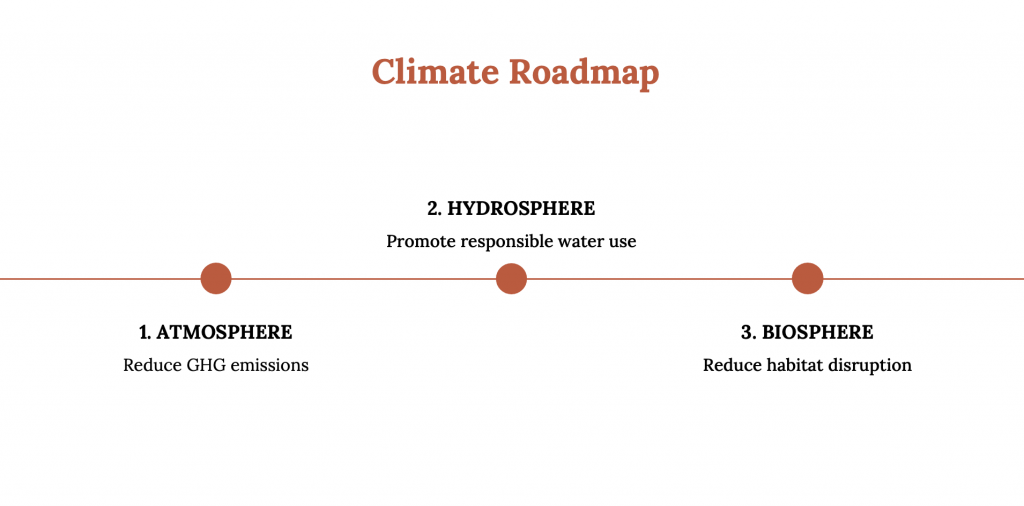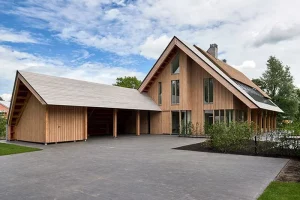Climate change is a catalyst for profound economic and social shifts, intensifying existing challenges such as political instability, income inequality, and infrastructure strains. While it’s challenging to attribute any single event solely to climate change, it is clear that rising global temperatures and environmental shifts aggravate vulnerabilities in societies already facing issues like inadequate infrastructure, automation, and demographic shifts. As a slow-moving but transformative force, climate change amplifies these pressures, highlighting the urgent need for robust adaptation and mitigation strategies.

But what is climate change? The weather can change instantaneously, but a change of climate develops over longer periods of time. The climate system is a complex network of five spheres that exchange water and energy in an ongoing cycle:
- Atmosphere: The layer of gases surrounding Earth.
- Biosphere: All living organisms, including ecosystems on land and in water.
- Cryosphere: Snow, ice, and permafrost on Earth’s surface.
- Geosphere: The Earth’s solid crust, including soils and rock layers.
- Hydrosphere: All water sources, including oceans, rivers, and groundwater.
Human activities, particularly the release of greenhouse gases, have had the largest impact on the atmosphere, trapping heat and driving a warming trend that disrupts this interdependent system.
Knowing this, for construction professionals aiming to support global climate goals, the top priority should be reducing greenhouse gas emissions to minimize the atmospheric impact that has got us into all this trouble. This means focusing on building low-carbon. After addressing atmospheric concerns, the next focus should be the hydrosphere. Construction can significantly impact water use, and small changes —like efficient water management practices, rainwater harvesting, and erosion control— can promote responsible water use with minimal costs. Finally, attention should be given to the biosphere. Changes in land use, such as deforestation or soil disruption, directly affect local ecosystems, so protecting biodiversity and reducing habitat disruption should remain key considerations in every project.

1. Atmosphere
A critical first step in low-carbon construction is enhancing energy efficiency, as emerging regulations are increasingly focusing first on limiting operational energy use. Investing in efficient equipment, installing renewable energy sources like solar panels, and conducting energy simulations before construction begins can significantly optimize energy performance and reduce long-term emissions. Once energy efficiency is addressed, the next step is minimizing the building’s embodied carbon, which mostly refers to the carbon footprint of materials used in construction. Choosing materials with Environmental Product Declarations (EPDs) is a good first step, as these documents provide transparency on a product’s carbon footprint. Focus on selecting low-carbon options for the most abundantly used materials in the building in question—concrete, wood, metals, plaster, and insulation—and make CO₂ emissions a key criterion in product selection.
2. Hydrosphere
Addressing the hydrosphere in construction begins with simple, cost-effective measures, such as installing water-efficient sanitary equipment. Regulations, like the European taxonomy, are beginning to mandate low-flow faucets and showerheads, which come with minimal financial impact for construction companies and yet contribute to significant water savings over the building’s lifespan. Once water flow efficiency is managed, further steps can include exploring systems for water harvesting, erosion control, and sustainable drainage solutions. For more guidance, resources like the Level(s) 5.3 indicator and the CIRIA C753 manual offer detailed practices for implementing sustainable water management strategies, ensuring long-term resilience and conservation.
3. Biosphere
Protecting the biosphere during construction is essential, as biodiversity loss ranks among the top environmental risks identified in the Global Risks 2020 Report. Ecosystems provide crucial services, from food and materials to climate regulation and clean air, making it vital for construction activities to minimize habitat disruption and protect biodiversity. A valuable tool in development for addressing the environmental impact of land use is the Land Use and Land Use Change (LULUC) carbon indicator, which will quantify carbon emissions associated with land-use changes, providing concrete data on the environmental impact of site alterations.
While the LULUC carbon indicator is still being refined, construction professionals can take other immediate steps to reduce ecological impact. Measures such as preserving natural areas, minimizing land disturbance, using native plants in landscaping, managing invasive species, and limiting pollution can help protect biodiversity and ecosystem health. These practices not only mitigate environmental impact but also foster resilience in both local ecosystems and the communities they support.

In conclusion, addressing climate change in construction is not only necessary but achievable through targeted, actionable steps that align with global priorities. By focusing first on reducing greenhouse gas emissions, construction professionals can make a substantial impact on atmospheric health through low-carbon practices, energy-efficient designs, and responsible material choices. Next, adopting simple water-saving measures and exploring sustainable water management options can contribute to hydrosphere conservation with minimal costs, enhancing long-term water resilience in buildings. Finally, protecting the biosphere by preserving ecosystems, minimizing land disruption, and choosing biodiversity-friendly practices safeguards essential natural services and fosters community resilience. Together, these steps form a comprehensive begginner’s approach to sustainable construction that supports both immediate and long-term environmental goals, reinforcing the industry’s role in building a climate-resilient future.



